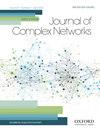基于信息的高维多元时间序列因果网络估计
IF 1.5
4区 数学
Q2 MATHEMATICS, INTERDISCIPLINARY APPLICATIONS
引用次数: 0
摘要
在复杂动力系统的研究中,最具挑战性的方面之一是对其潜在的相互依存结构的估计。在大数据时代,这个问题变得更加复杂,因为有更多的观察变量可用。为了估计在这种情况下的直接因果关系效应,在格兰杰因果关系测度中必须采用降维。该措施还应该能够检测非线性效应,持续存在于现实世界的复杂系统。基于无模型信息的混合嵌入部分互信息度量(PMIME)已被开发用于解决这些问题,并被发现在中高维的多变量时间序列上表现良好。本文研究了由直接的、可能是非线性的、高维的数百阶时间序列形成复杂网络的问题。在离散时间(耦合hsamnon映射)和连续时间(耦合Mackey-Glass延迟微分方程)两个耦合动力系统上测试了PMIME测度的性能。由此得出结论,对潜在因果网络的正确检测主要取决于网络密度,而不是其大小(节点数)。最后,通过对英国脱欧前后英国股票市场的研究,考察了网络规模的影响。本文章由计算机程序翻译,如有差异,请以英文原文为准。
Information-based estimation of causality networks from high-dimensional multivariate time series
One of the most challenging aspects in the study of the complex dynamical systems is the estimation of their underlying, interdependence structure. Being in the era of Big Data, this problem gets even more complicated since more observed variables are available. To estimate direct causality effects in this setting, dimension reduction has to be employed in the Granger causality measure. The measure should also be capable to detect non-linear effects, persistently present in real-world complex systems. The model-free information-based measure of partial mutual information from mixed embedding (PMIME) has been developed to address these issues and it was found to perform well on multivariate time series of moderately high dimension. Here, the problem of forming complex networks from direct, possibly non-linear, high-dimensional time series at the order of hundreds is investigated. The performance of the measure PMIME is tested on two coupled dynamical systems in discrete time (coupled Hénon maps) and continuous time (coupled Mackey–Glass delay differential equations). It is concluded that the correct detection of the underlying causality network depends mainly on the network density rather than on its size (number of nodes). Finally, the effect of network size is investigated in the study of the British stock market in the period around Brexit.
求助全文
通过发布文献求助,成功后即可免费获取论文全文。
去求助
来源期刊

Journal of complex networks
MATHEMATICS, INTERDISCIPLINARY APPLICATIONS-
CiteScore
4.20
自引率
9.50%
发文量
40
期刊介绍:
Journal of Complex Networks publishes original articles and reviews with a significant contribution to the analysis and understanding of complex networks and its applications in diverse fields. Complex networks are loosely defined as networks with nontrivial topology and dynamics, which appear as the skeletons of complex systems in the real-world. The journal covers everything from the basic mathematical, physical and computational principles needed for studying complex networks to their applications leading to predictive models in molecular, biological, ecological, informational, engineering, social, technological and other systems. It includes, but is not limited to, the following topics: - Mathematical and numerical analysis of networks - Network theory and computer sciences - Structural analysis of networks - Dynamics on networks - Physical models on networks - Networks and epidemiology - Social, socio-economic and political networks - Ecological networks - Technological and infrastructural networks - Brain and tissue networks - Biological and molecular networks - Spatial networks - Techno-social networks i.e. online social networks, social networking sites, social media - Other applications of networks - Evolving networks - Multilayer networks - Game theory on networks - Biomedicine related networks - Animal social networks - Climate networks - Cognitive, language and informational network
 求助内容:
求助内容: 应助结果提醒方式:
应助结果提醒方式:


